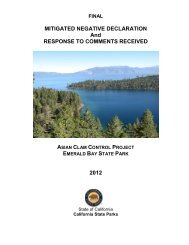Anza Borrego Desert State Park - California State Parks - State of ...
Anza Borrego Desert State Park - California State Parks - State of ...
Anza Borrego Desert State Park - California State Parks - State of ...
You also want an ePaper? Increase the reach of your titles
YUMPU automatically turns print PDFs into web optimized ePapers that Google loves.
Final Report – October 2001<br />
How Do Visitors View the Acceptability <strong>of</strong> Ecological,<br />
Managerial and Social Conditions Within the <strong>Park</strong>?<br />
In addition to the information gathered to this point, managers are interested in the<br />
specific reactions <strong>of</strong> <strong>Park</strong> visitors when presented with a range <strong>of</strong> conditions that might<br />
be found within the <strong>Park</strong>. The issues presented were:<br />
1. Off-road use, vegetation loss – Coyote Canyon<br />
2. Crowding, solitude – Blair Valley, Fish Creek<br />
3. Trail standards – <strong>Borrego</strong> Palm Canyon, Mountain Palm Springs<br />
The Photo Series<br />
For the last set <strong>of</strong> questions in the survey, six images were used to measure the<br />
acceptability <strong>of</strong> a range <strong>of</strong> ecological or managerial conditions. To do this in a<br />
meaningful way, UM researchers worked with <strong>Park</strong> staff to produce a possible<br />
progression <strong>of</strong> scenarios depicting a reasonable scope <strong>of</strong> conditions. In Coyote Canyon,<br />
the photo set portrayed a range <strong>of</strong> vegetation loss due to <strong>of</strong>f-road vehicle use (Panel 1).<br />
For Blair Valley and Fish Creek survey locations, a similar photo collection was used<br />
depicting a range from solitude to highly crowded conditions (Panels 2 and 3). For<br />
Mountain Palm Springs and <strong>Borrego</strong> Palm Canyon, the photo series depicted a<br />
continuum <strong>of</strong> trail conditions spanning low use and low standard, to very high use, the<br />
trail signed and paved (Panes 4 and 5). Respondents at each site were asked to judge<br />
the acceptability <strong>of</strong> the six photos along a nine-point scale, from –4 (very unacceptable)<br />
to +4 (very acceptable), with a neutral zero point.<br />
The photos used in each <strong>of</strong> the three sets were artificially enhanced by computer. An<br />
original photo was scanned for each photo set and then elements were added, removed,<br />
or otherwise manipulated in order to create the effect. For example, in the Coyote<br />
Canyon photo set, Photo 1 is the original image, with a sign removed for simplicity. All<br />
other characteristics in the subsequent photos in that set were airbrushed or otherwise<br />
manipulated to depict increasing levels <strong>of</strong> vegetation loss and impacts associated with<br />
<strong>of</strong>f-road vehicle use. For Blair Valley and Fish Creek, the original image is Photo 6, with<br />
other photos showing a progression <strong>of</strong> more campers, from none in Photo 1 to extremely<br />
crowded conditions in Photo 6. In the photo set for <strong>Borrego</strong> Palm Canyon and Mountain<br />
Palm Springs, Photo 5 is the original, with more or less trail development and<br />
maintenance portrayed in the other photos.<br />
Acceptability <strong>of</strong> Vegetation Loss at Coyote Canyon<br />
We used two different methods to evaluate the visitors’ responses to the photo series <strong>of</strong><br />
questions. First, the mean <strong>of</strong> the responses for both fall and spring were plotted for each<br />
<strong>of</strong> the photos. A positive mean score indicates that the conditions represented in the<br />
photo were acceptable, while a negative mean score suggests that the conditions<br />
represented in the photo were unacceptable to most visitors who participated in the<br />
study. Second, we evaluated the 50 th percentile <strong>of</strong> respondents and the photo in the<br />
series where they shifted from “acceptable” to “unacceptable” (Tables 37 and 38)<br />
43
















